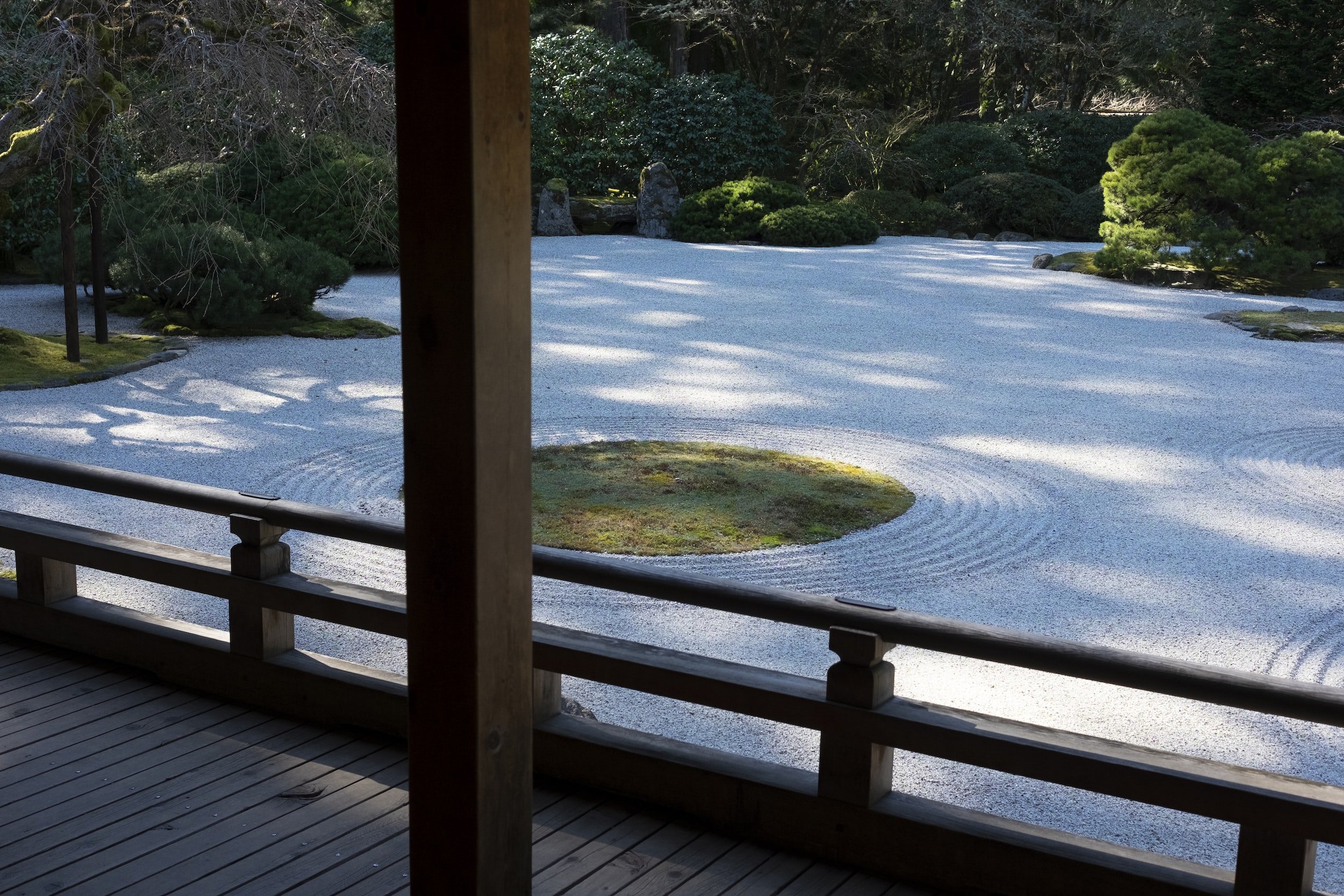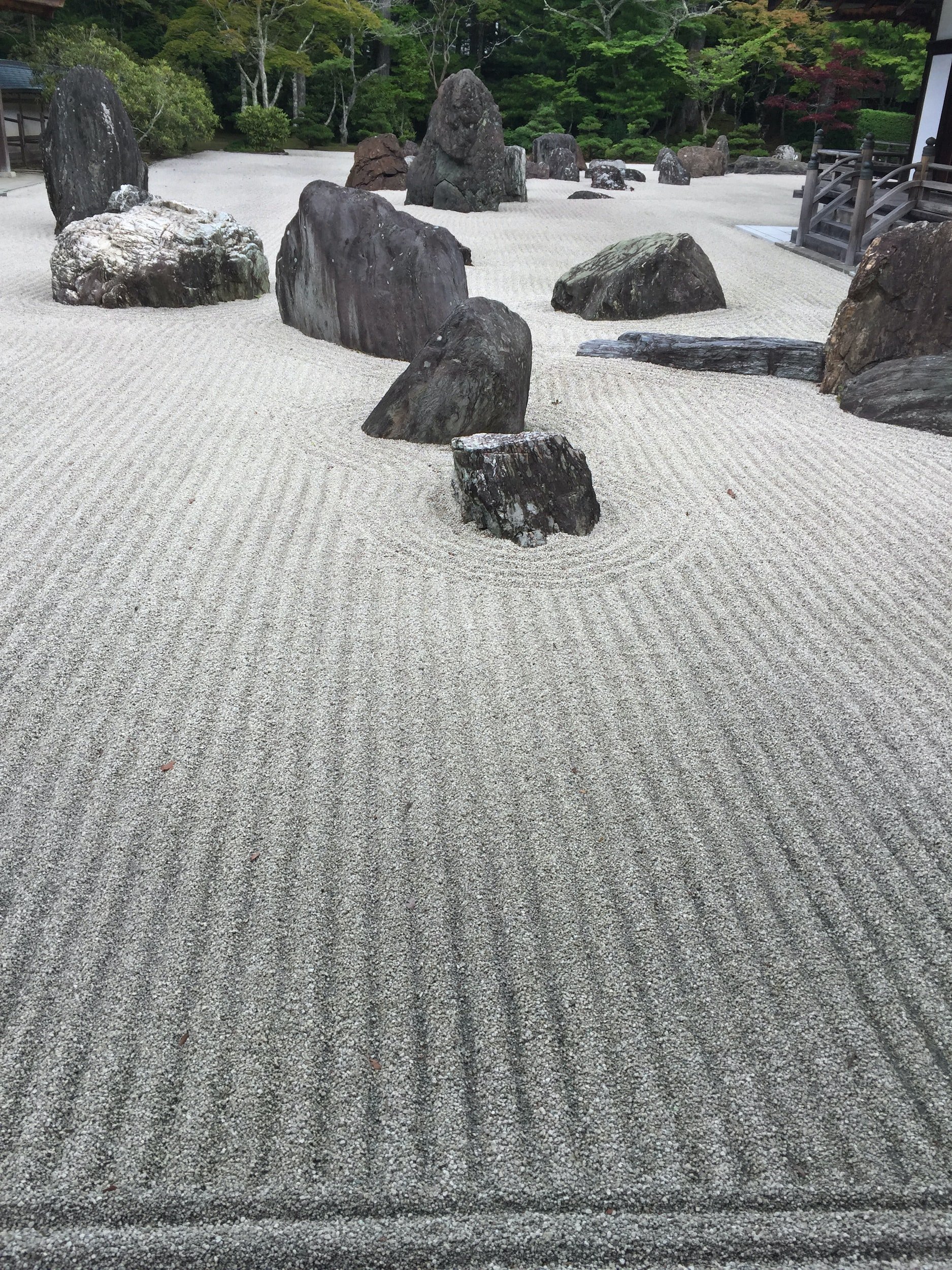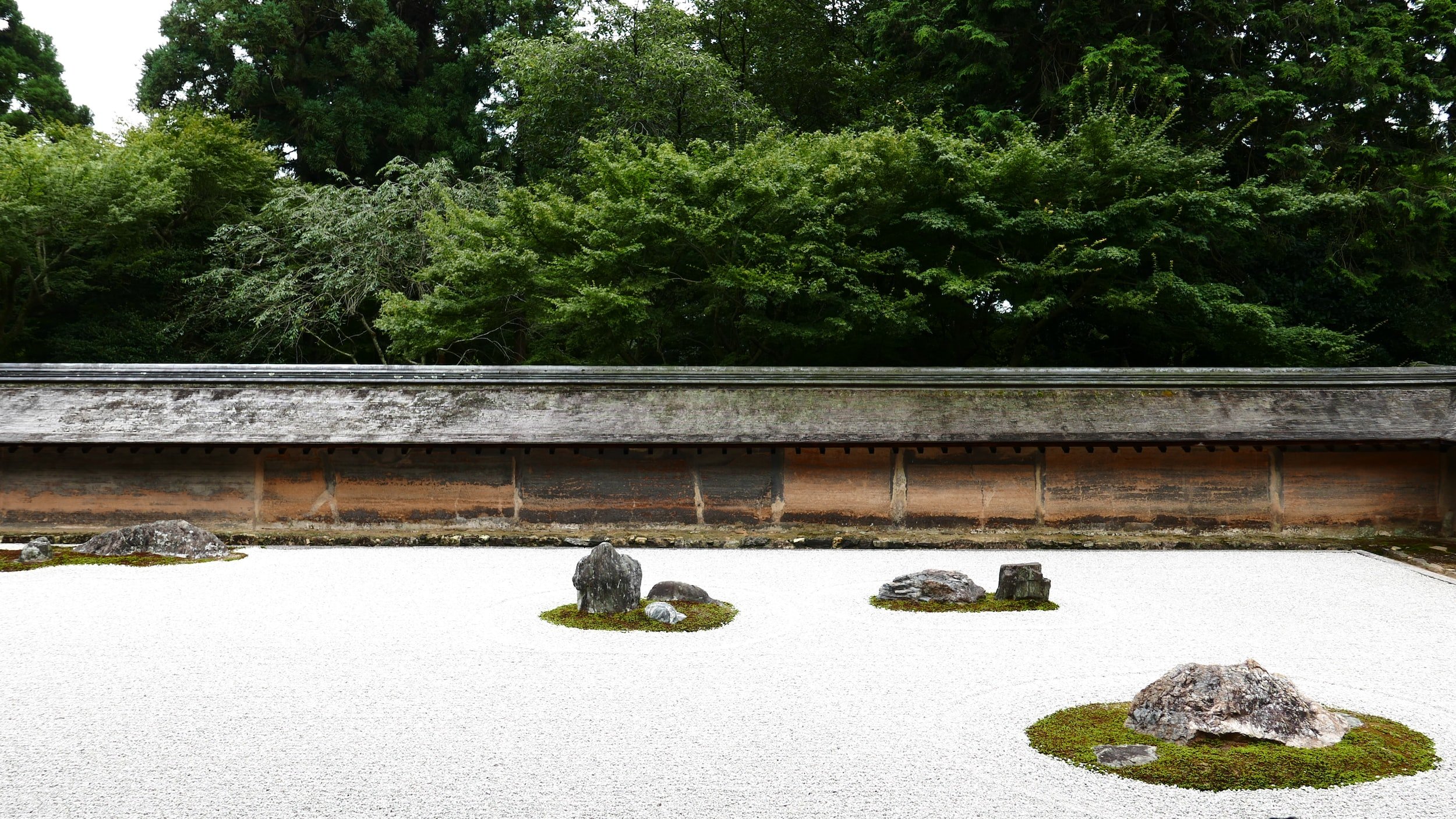How to get Started Raking a Zen Garden
The History of Zen Gardens
Zen gardens are a unique form of Japanese gardening, first appearing in the late 12th century. Based on the principles of Zen Buddhism, these rock gardens were initially intended to be places for reflection and meditation. Over time, they have become popular all over the world and can now be found in many public and private spaces.
The design of Zen gardens is based on monochromatic colors and natural elements like rocks and sand. These materials are used to create patterns that symbolize balance and harmony, which are integral concepts in the practice of Zen Buddhism. The goal is to create an atmosphere of peace and tranquility by focusing on simplicity rather than extravagance.
One iconic element of many Zen gardens is a small bridge leading across a pond, giving the illusion of depth. Bridges are said to represent the journey from one's existing state of mind to inner peace. Other popular elements include lanterns, stone ornaments, and water basins.
These gardens have become an important part of Japanese culture, but they have also found a place in other countries as well. It is not uncommon for private homes and public parks to feature these gardens today. Many people find that spending time in these peaceful spaces helps them relax and reflect on life, creating a much-needed respite from the stresses of everyday life.
Regardless of where you are in the world, it is easy to appreciate the beauty and tranquility of a Zen rock garden. By embracing the principles of simplicity, balance, and harmony, they can be a great source of inspiration for anyone looking to create an oasis in their own space.
How do Zen Gardens fit into Japanese Culture?
Zen gardens are an integral part of Japan's culture. They provide a sense of peace and harmony within the natural environment, allowing individuals to contemplate life in serenity. These tranquil scenes offer a chance to relax, reflect and ponder upon one's existence.
The earliest gardens were constructed in Japan during the Heian period (794-1185 AD). Many of these traditional gardens featured rocks, white sand, and gravel which were carefully raked into patterns or shapes as part of a meditative practice known as karesansui (‘dry landscape’) gardening. As Buddhism spread through Japan, the Karesansui Garden became more elaborate, with additions such as shrines, pagodas, ponds, and bridges added to their composition. There are even special traditional Japanese gardening shoes that are used when maintaining the rock garden.
Zen sand gardens remain popular in Japan today, with many modern interpretations of the classic designs. From small desk-top gardens to full-scale lake/land landscapes, these miniature versions of nature offer an opportunity for people to enjoy the beauty and serenity of nature without having to leave their homes.
Choosing the Zen Garden for You
Zen rock gardens are designed to promote relaxation and meditation. They typically feature minimalistic designs with carefully arranged rocks, sand, and gravel. If you're interested in creating your own, there are a few different types to consider.
Here's a breakdown of some of the most popular styles.
Mini Zen Garden
These small tabletop gardens are perfect for those who want to bring a sense of calmness into their living space or workplace. They often come with a small tray or container filled with sand or other materials and can be customized with miniature rakes, stones, and other accessories.
Japanese Rock Garden
Also known as "karesansui," a rock garden typically features a dry landscape with large rocks arranged in patterns within a bed of sand or gravel. The design is meant to represent natural landscapes like mountains and rivers and is often found in temples or other religious sites.
Traditional Japanese Gardens
A larger Japanese garden typically includes water features like ponds or streams, along with carefully arranged plants and stones. They often have winding paths that lead visitors through the space, encouraging a sense of exploration and contemplation.
Sand and Stone Garden
Similar to the Japanese rock garden, this type of zen garden features carefully arranged stones within a bed of sand or gravel. However, it may also incorporate elements like mosses or small plants to add texture and interest.
When choosing the right type of Japanese garden for you, consider factors such as your available space (a small version might be best if you have limited room), your level of experience (traditional Japanese gardens may require more maintenance than simpler designs), and your personal taste (do you prefer minimalist designs or something more lush?). You should also think about whether you plan to use your zen garden for meditation purposes or simply as an aesthetic addition to your home.
Different Rake Options
Japanese gardens typically feature minimalistic designs with carefully arranged rocks, sand, and gravel. However, one of the most important elements of a zen garden is the wooden rake or tool used to create patterns in the sand. Here are some different options for zen garden rakes and tools:
Traditional Zen Rake
The traditional zen wooden rake is made from bamboo and features long tines that can be used to create intricate patterns in the sand. It's a simple yet effective tool that's perfect for beginners.
Miniature Rakes
If you have a mini version on your desk or tabletop, a miniature wooden rake can be used to create patterns in the smaller space. They're often sold as part of a kit with the mini garden itself.
Adjustable Rakes
These rakes have adjustable teeth that allow you to change the width of the lines you're creating in the sand. This can be useful for creating different textures and patterns within your zen garden.
Shovel Tools
Some people prefer using small shovels or scoops instead of a wooden rake to move sand around their zen garden instead of using a rake. These tools can help create more organic shapes and patterns in the sand.
DIY Tools
If you're feeling crafty, you can even create your own custom rake or tool for your zen garden! Some people use forks, combs, or even toothbrushes to make unique patterns in the sand.
When choosing a wooden rake or tool for your zen garden, consider factors such as personal preference (do you prefer straight lines or more organic shapes?), size of your garden (a mini rake may not work well in a larger space), and material (bamboo rakes are traditional but metal rakes may be more durable).
Ultimately, whichever type of tool you choose should feel comfortable in your hand and allow you to express yourself creatively while promoting relaxation and mindfulness through this meditative practice.
Experiment with Patterns
One of the most important elements of a zen garden is the pattern you create in the sand using a wooden rake or other tool. Here are some different patterns you can rake into your zen garden.
Straight Lines
This classic pattern involves raking straight lines in parallel rows. You can vary the distance between each straight-line pattern to create different effects.
Curvy Lines
If you prefer a more organic look for your zen garden, try raking a curvy line instead of straight ones. This can create a sense of movement and flow within the space.
Wiggly Lines
Similar to curvy lines, wiggly lines add an extra element of playfulness to your zen garden design. Try alternating between short and long wiggles for a unique effect.
Circles
Circles are another classic pattern that can be used in various sizes throughout your zen garden design. They represent unity and wholeness and can help create a sense of balance within the space.
Meandering Stream Pattern
This pattern involves creating a winding path through your zen garden using your rake or tool. It's perfect for larger spaces and can be used to mimic the appearance of a natural stream or river.
Your Own Pattern
Don't be afraid to get creative and come up with your own unique pattern for your zen garden! Whether it's geometric shapes, spirals, or something completely original, this is an opportunity to express yourself creatively while promoting mindfulness and relaxation.
When choosing a pattern for your zen garden, consider factors such as personal preference (do you prefer straight lines or more organic shapes?), size of your garden (larger spaces may require more intricate patterns), and intended use (are you using it for meditation purposes or simply as an aesthetic addition to your home?). Ultimately, whichever pattern you choose should feel calming and soothing while reflecting your unique style preferences!
How to Benefit from a Japanese Garden
In today's fast-paced world, it can be difficult to find moments of peace and relaxation. This is where a zen garden can come in handy. Japanese gardens are designed to promote mindfulness and meditation through minimalistic designs featuring carefully arranged rocks, sand, and gravel. Here are some benefits you can experience from having a dry landscape zen garden.
Stress Reduction: One of the most obvious benefits of a zen garden is its ability to reduce stress levels. The act of raking patterns in the sand can help calm your mind and provide a sense of relaxation.
Improved Focus: When working on your zen garden, you're forced to focus on the task at hand rather than letting your mind wander. This can help improve your overall focus and concentration levels.
Mindfulness Practice: They are also great tools for practicing mindfulness, which involves being fully present in the moment without judgment or distraction. By focusing on the simple act of raking patterns in the sand, you can train your brain to stay present and aware.
Creative Expression: Raking patterns in the sand is an opportunity for creative expression within a peaceful environment. Experiment with different shapes and textures to create unique designs that reflect your personal style.
Sense of Accomplishment: Completing a design in your zen garden can provide a sense of accomplishment and pride that carries over into other areas of life.
Improved Sleep: Engaging in relaxing activities like tending to a zen garden has been shown to improve sleep quality by reducing anxiety levels before bedtime.
Overall, incorporating a dry landscape zen garden into your daily routine can provide numerous benefits for both mental health and overall well-being. Whether you're looking for stress reduction techniques or simply enjoy creative expression within a calming environment, this meditative practice may be worth exploring!
Designing Your Own Zen Garden
Choose Your Space: The first step in creating a zen garden is selecting the space where it will be located. They can be created indoors or outdoors, but it's important to choose an area that is quiet and free from distractions.
Select Your Materials: The main materials needed for a zen garden include sand or gravel, rocks of various sizes and shapes, and any additional decorative elements you may want to include (such as moss or small plants). You can find these items at your local craft store or home improvement center.
Pick Your Container: Once you have your materials, you'll need to select a container for your zen garden. This could be anything from a shallow dish to a wooden box - just make sure it's large enough to hold all of your materials.
Arrange Your Rocks: Start by arranging the rocks in the container in a way that is pleasing to the eye. You can create patterns or groupings depending on your personal preferences.
Add Sand/Gravel: After arranging the rocks, pour sand or gravel over them until they are mostly covered. Use a rake or other tool to create patterns in the sand/gravel.
Decorate (Optional): If desired, you can add additional decorative elements such as moss or small plants to enhance the visual appeal of your zen garden.
Enjoy! Once your zen garden is complete, take some time each day to tend to it and rake patterns in the sand/gravel as desired.
Additional Resources
If you're interested in learning more about these wonderful sand and rock gardens and how to create your own, there are a number of resources available to help you get started.
Books
There are countless books available that cover the topic of zen gardens in-depth. Some popular titles include "The Art of the Japanese Garden" by David Young and Michiko Young, "Creating Your Own Japanese Garden" by Takashi Sawano, and "The Zen Garden" by Mira Locher.
Online Articles
If you prefer to do your research online, there are a wealth of articles available on websites such as Houzz, The Spruce, and Better Homes & Gardens that cover everything from the history of zen gardens to step-by-step instructions for creating your own.
YouTube Tutorials
For those who learn best through visual instruction, YouTube offers a plethora of tutorials on creating zen gardens. Channels such as The Samurai Carpenter and DIY Creators offer detailed step-by-step guides that can be helpful for beginners.
Local Workshops
If you prefer hands-on learning experiences, consider searching for local workshops or classes on creating zen gardens. Many gardening centers and community centers offer classes on this topic where you can learn from experienced instructors and connect with other garden enthusiasts.
Social Media
Finally, social media platforms such as Instagram and Pinterest can be great sources of inspiration when it comes to designing your own zen garden. Follow accounts dedicated to gardening for ideas on different materials, designs, and decorative elements.
Whether you prefer reading books or watching video tutorials, there are plenty of resources available to help you learn more about zen gardens and how to create your own tranquil space at home or work. With some patience and creativity, anyone can create a beautiful and meditative space that promotes mindfulness and relaxation.
Remember to Have Fun with Your Zen Garden!
When most people think of a zen garden, they picture a calming and meditative space for reflection and relaxation. While this is certainly true, your zen garden can also be a source of fun and creativity! Here are some ideas for how you can have fun with your zen garden:
Experiment with Different Patterns
Raking patterns in the sand/gravel is one of the most common ways to tend to a zen garden, but that doesn't mean you have to stick to traditional designs. Try experimenting with different shapes and textures to create unique patterns that reflect your personal style.
Add Decorative Elements
While rocks are the main decorative element in most zen gardens, there's no reason why you can't add other items as well. Consider adding small statues, figurines, or even small toys to your garden for an added touch of whimsy.
Host Mini Zen Garden Contests
If you have friends or family members who also enjoy tending to their own zen gardens, consider hosting mini contests where each person creates their own design and everyone votes on their favorite.
Use Your Imagination
There are no hard and fast rules when it comes to creating a zen garden, so feel free to use your imagination! You could create miniature scenes using rocks and other elements or even incorporate different colors of sand/gravel for added visual interest.
Incorporate Sounds
The sound of running water or wind chimes can be incredibly soothing, so consider incorporating these elements into your zen garden as well.
Make it a Group Activity
Tending to a zen garden can be an enjoyable group activity as well! Invite friends over for some tea or snacks while everyone works on their own gardens together.
Remember that the main goal of a zen garden is still relaxation and mindfulness - but that doesn't mean you can't have some fun with it too! By incorporating playful elements into your design process, you may find yourself feeling even more relaxed and at peace than before.










